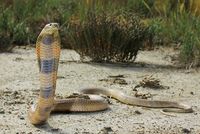Central Asian cobra
| Central Asian cobra | ||||||||||||||||||||
|---|---|---|---|---|---|---|---|---|---|---|---|---|---|---|---|---|---|---|---|---|
 Central Asian cobra
| ||||||||||||||||||||
| Conservation status | ||||||||||||||||||||
|
Data Deficient[1]
| ||||||||||||||||||||
| Scientific classification | ||||||||||||||||||||
| ||||||||||||||||||||
| Binomial name | ||||||||||||||||||||
| Naja oxiana (Eichwald, 1831)[2][3] | ||||||||||||||||||||
| Synonyms | ||||||||||||||||||||
|
The Central Asian cobra (Naja oxiana), also commonly known as the Caspian cobra and Oxus cobra, is a highly venomous species of cobra found in central Asia and belongs to the Elapidae family. It occurs in central Asia and like other cobra species, it spreads a “hood” as a warning potential predators and other threats. The species is protected in Tajikistan, Turkmenistan and Uzbekistan.
Etymology
The Central Asian cobra was described by Russian geologist and physician Karl Eichwald in 1831.[4] The generic name naja is a Latinisation of the Sanskrit word nāgá (नाग) meaning "cobra". The specific epithet oxiana refers to the region surrounding the Amu Darya River which flows along Afghanistan's northern border separating it from Tajikistan and Uzbekistan before turning northwest into Turkmenistan to the Aral Sea. In ancient times, the river was known as the Oxus in Greek.[5]
Description
This species is medium in length, heavy bodied snake with long cervical ribs capable of expansion to form a hood when threatened. The body is compressed dorsoventrally and subcylindrical posteriorly. The head is elliptical, depressed, slightly distinct from the neck with a short, rounded snout and large nostrils. The eyes are medium in size with round pupils. Dorsal scales are smooth and strongly oblique with the outer 2 or 3 scale rows larger than remainder. Adult specimens average between 1.1 m (3.61 ft) and 1.4 m (4.59 ft) in length. Specimens longer than 1.5 m (4.92 ft) are rare. This species exhibits considerable ontogenetic variation in its pattern. Juveniles are strongly banded, dorsally and ventrally. Anteriorly, the dark and light bands are approximately 3-5 ventrals wide, of equal width, and completely encircle the body. Going back along the body, the bands become narrower, and less clear on the ventral side. The ventral banding disappears altogether in the posterior third of the body. Going back, the dorsal light bands split into double bands, which then split into quadruple bands, and so on. The total number of light bands is around 45. Despite the presence of very obvious bands, the general appearance of the young specimens is very faded. The banding fades slowly with increasing size, but is still faintly visible, at least in the anterior part of the body, in young adults up to 90 cm (2.95 ft) and 100 cm (3.28 ft).
Cited references
- ↑ Naja oxiana. The IUCN Red List of Threatened Species. IUCN Red List of Threatened Species. Retrieved on 15 May 2012.
- ↑ Naja atra (TSN 700635) at Integrated Taxonomic Information System. Accessed 15 May 2012.
- ↑ Naja oxiana (EICHWALD, 1831) at The Reptile Database. Accessed 15 May 2012.
- ↑ Eichwald, E. (1831). Zoologia specialis, quam expositis animalibus tum vivis, tum fossilibus potissimuni rossiae in universum, et poloniae in specie, in usum lectionum publicarum in Universitate Caesarea Vilnensi. Zawadski, Vilnae.
- ↑ Byron, Robert. (1982). The Road to Oxiana. Oxford University Press, USA. 292 pp. ISBN 0195030672